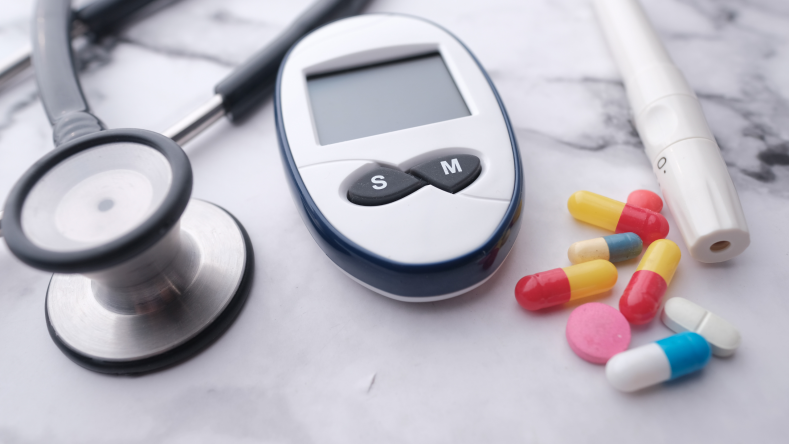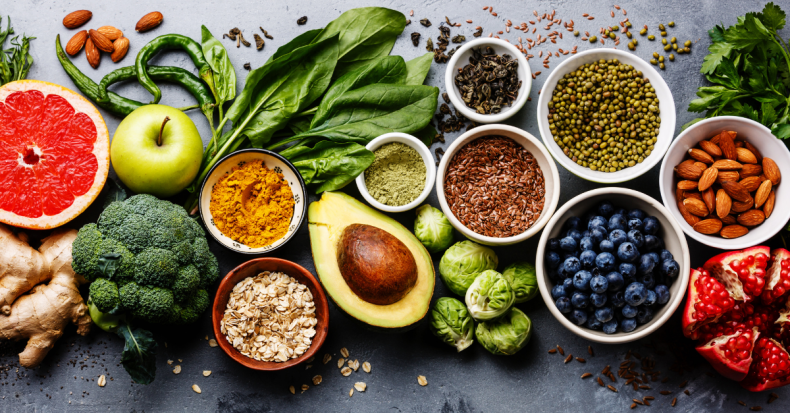Science-based lifestyle strategies for lowering HbA1c
HbA1c tests can be used by healthcare providers to diagnose or monitor certain diseases such as pre-diabetes and diabetes. Learn more about how you can lower your HbA1c naturally.

If you’re concerned about your risk of developing pre-diabetes or diabetes, you may have heard of the hemoglobin A1C test. But what is it, how is it calculated, and what does it tell you about your health? Before diving into what science has to say about reducing HbA1c, let’s discuss each of these points in more detail.
What is HBA1c?
If you have an excess buildup of glucose, it binds to a protein called hemoglobin in your red blood cells. Hemoglobin A1c (also known as HbA1c) is a blood test used to measure how much glucose is bound to your red blood cells and reflects what percentage of your red blood cells have sugar-coated hemoglobin [ 2
Since symptoms of pre-diabetes and diabetes often go undetected, it’s beneficial to know your A1c level even if you’re not at high risk for developing these conditions.
Interpreting HbA1c levels
HbA1c measures your average blood sugar levels over the course of the last 2-3 months, and is reported as a percentage [ 1
Here are what the results of an HbA1c test mean [ 1
Optimal: Your levels are considered normal if they are below 5.7%. For people without diabetes, the normal range for hemoglobin A1c is between 4% and 5.6%.
Elevated: If your levels are between 5.7-6.4%, you might be pre-diabetic, which increases your risk of type 2 diabetes, heart disease, and stroke.
High: Levels at or above 6.5% are typically an indicator of diabetes, which raises your risk of heart disease, stroke, kidney disease, visual impairment, neuropathy, and various other conditions.
You should discuss your HbA1c levels with a healthcare provider to determine if a treatment plan is necessary.
What impacts HbA1c?
Many factors play a role in your A1c level, such as:
Diet, particularly those high in refined carbohydrates and added sugars, and low in fiber
Overweight or obese individuals
Sedentary lifestyle
Age (specifically adults ages 45 or older)
High blood pressure
Low HDL cholesterol levels
Race (people of Black, Hispanic/Latino, American Indian, Asian American, or Pacific Islander descent are at greater risk for pre-diabetes/diabetes.)
Stress
Certain medications, including glucocorticoids
Genetics (family history of pre-diabetes or diabetes)
Pregnancy
PCOS
Let your doctor know if any of these apply to you to determine if you need follow-up testing.
How to lower HbA1c
Making changes to your diet and lifestyle habits can have a positive effect on HbA1c. Here are some science-backed ways that you can lower HbA1c levels over time.

Focus on nutrition.
Studies have found that a diet focused on whole grains, lean protein, non-starchy vegetables, and plant-based fat can significantly help with blood sugar control [ 4 5

Engage in physical activity.
Regular exercise is a great way to improve your A1c. While all forms of exercise offer incredible health benefits, studies have shown that a combination of strength training and aerobic exercise is even more beneficial in lowering HbA1c [ 7
Maintain a healthy weight.
If you’re overweight or obese, losing excess weight can greatly benefit HbA1c levels, as research shows a 0.1% reduction in HbA1c for every 1 kg of body weight lost [ 3

Reduce stress and get adequate sleep.
High stress levels and poor sleep quality have a linear relationship with weight gain 6 8
If you have trouble falling (or staying) asleep, here are some
supplements that may help
.

Consider a supplement.
According to research, supplementation may help with blood sugar control. Cinnamon, probiotics, berberine, vitamin D, and magnesium are just a few supplements that have been shown to decrease A1c and improve insulin sensitivity [ 9 10 11 12 13 here
While supplementation can be an effective way to lower A1c levels, they aren't a standalone strategy. Talk with your healthcare provider to see which supplements may work best for you.
Summary
HbA1c provides a deeper insight into blood sugar levels, and can help determine if your body is producing enough insulin or encountering insulin resistance. As such, it’s most often used to diagnose pre-diabetes and diabetes and monitor the effectiveness of interventions to manage blood sugar. While it’s recommended to speak with a healthcare provider to determine a treatment plan, you can also lower HbA1c levels through diet, exercise, and other positive lifestyle changes.
Disclaimer: The text, images, videos, and other media on this page are provided for informational purposes only and are not intended to treat, diagnose or replace personalized medical care.
Key takeaways
HbA1c is most often used to diagnose pre-diabetes and diabetes and monitor the effectiveness of interventions to manage blood sugar.
For people without diabetes, the normal range for hemoglobin A1c is between 4% and 5.6%.
HbA1c levels at or above 6.5% are within the diabetes range, which raises your risk of heart disease, stroke, kidney disease, visual impairment, neuropathy, and various other conditions.
You can reduce your HbA1c levels with a more nutritious diet, increased physical activity, weight management, stress reduction, and better quality sleep.
References:
Centers for Disease Control and Prevention. (2021, August 10). All about your A1C. Centers for Disease Control and Prevention. Retrieved January 17, 2022, from
https://www.cdc.gov/diabetes/managing/managing-blood-sugar/a1c.html
U.S. National Library of Medicine. (2021, September 15). Hemoglobin A1C (hba1c) test: Medlineplus medical test. MedlinePlus. Retrieved January 17, 2022, from
https://medlineplus.gov/lab-tests/hemoglobin-a1c-hba1c-test/
Gummesson, A., Nyman, E., Knutsson, M., & Karpefors, M. (2017). Effect of weight reduction on glycated haemoglobin in weight loss trials in patients with type 2 diabetes. Diabetes, obesity & metabolism, 19(9), 1295–1305.
https://doi.org/10.1111/dom.12971
Utami, D. B., & Findyartini, A. (2018). Plant-based Diet for HbA1c Reduction in Type 2 Diabetes Mellitus: an Evidence-based Case Report. Acta medica Indonesiana, 50(3), 260–267.
Katherine D. McManus, M. S. (2021, November 16). What is a plant-based diet and why should you try it? Harvard Health. Retrieved January 17, 2022, from
https://www.health.harvard.edu/blog/what-is-a-plant-based-diet-and-why-should-you-try-it-2018092614760
Zamani-Alavijeh, F., Araban, M., Koohestani, H. R., & Karimy, M. (2018). The effectiveness of stress management training on blood glucose control in patients with type 2 diabetes. Diabetology & Metabolic Syndrome, 10(1).
https://doi.org/10.1186/s13098-018-0342-5
The importance of exercise when you have diabetes. Harvard Health. (2021, February 3). Retrieved January 17, 2022, from
https://www.health.harvard.edu/staying-healthy/the-importance-of-exercise-when-you-have-diabetes
Grandner, M. A., Seixas, A., Shetty, S., & Shenoy, S. (2016). Sleep Duration and Diabetes Risk: Population Trends and Potential Mechanisms. Current diabetes reports, 16(11), 106.
https://doi.org/10.1007/s11892-016-0805-8
Ziegenfuss, T. N., Hofheins, J. E., Mendel, R. W., Landis, J., & Anderson, R. A. (2006). Effects of a water-soluble cinnamon extract on body composition and features of the metabolic syndrome in pre-diabetic men and women. Journal of the International Society of Sports Nutrition, 3(2), 45–53.
https://doi.org/10.1186/1550-2783-3-2-45
Zhang, Q., Wu, Y., & Fei, X. (2016). Effect of probiotics on glucose metabolism in patients with type 2 diabetes mellitus: A meta-analysis of randomized controlled trials. Medicina (Kaunas, Lithuania), 52(1), 28–34.
https://doi.org/10.1016/j.medici.2015.11.008
Yin, J., Xing, H., & Ye, J. (2008). Efficacy of berberine in patients with type 2 diabetes mellitus. Metabolism: clinical and experimental, 57(5), 712–717.
https://doi.org/10.1016/j.metabol.2008.01.013
Mitri, J., Dawson-Hughes, B., Hu, F. B., & Pittas, A. G. (2011). Effects of vitamin D and calcium supplementation on pancreatic β cell function, insulin sensitivity, and glycemia in adults at high risk of diabetes: the Calcium and Vitamin D for Diabetes Mellitus (CaDDM) randomized controlled trial. The American journal of clinical nutrition, 94(2), 486–494.
https://doi.org/10.3945/ajcn.111.011684
Morais, J., Severo, J. S., de Alencar, G., de Oliveira, A., Cruz, K., Marreiro, D., Freitas, B., de Carvalho, C., Martins, M., & Frota, K. (2017). Effect of magnesium supplementation on insulin resistance in humans: A systematic review. Nutrition (Burbank, Los Angeles County, Calif.), 38, 54–60.
https://doi.org/10.1016/j.nut.2017.01.009
